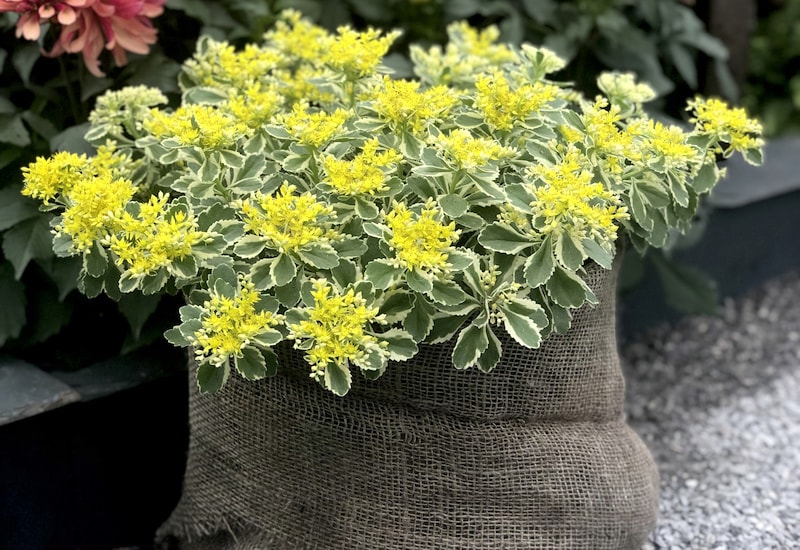We love alpines and rockery plants and were delighted when the RHS judges named Sedum ‘Atlantis’ Plant of the Year 2019 at the Chelsea Flower Show. Read on to learn more about the origins of this fascinating succulent and how to make the most of it in your garden.
Browse our drought tolerant plants to see our full range of colourful stonecrops.
The history of Sedum ‘Atlantis’
The original Sedum Takesimense was found on a volcanic island off Korea, where it had adapted to the well-drained soils. It has been grown in nurseries for a number of years, where it is sold as a garden plant or used for green roofs.
Dave Mackenzie is a sedum specialist and has written books on green roofs and vertical gardens. Several years ago, whilst doing a daily check through his nursery on the banks of Lake Michigan, Dave spotted that one of his Sedum Takesimense plants had developed with striking variegated leaves. He was immediately excited about its potential and, over the following six years, tested its vigour and consistency until he was ready to release it to the public. Dave showed the plant to Peter Van Rijssen who travels the world looking for new and exciting plants, and he, in turn, showed it to Gavin Shaw, one of Suttons’ own ‘plant hunters’. Our horticultural team loved the plant when we saw the photos and we were even more impressed when we started growing it at our nursery down in Devon.
A sedum for foliage as well as flowers

Image: Suttons
Most sedums sit quietly in the background and then surprise you with a burst of pollinator-friendly flowers. But when we were choosing plants to take to Chelsea for judging we genuinely struggled to choose. Should we take Sedum ‘Atlantis’ plants that were in bloom, or concentrate on showing off the foliage because it’s THAT striking? Initially emerging as pure cream, the leaf rosettes of Sedum ‘Atlantis’ develop into serrated green leaves with striking creamy margins, expanding to form a cushion up to 50cm across. The plant covers itself with a foam of yellow flowers from July to September and finally, the leaves take on a lovely autumn pink blush.
How to care for your Sedum ‘Atlantis’

Image: Suttons
Whilst Sedum ‘Atlantis’ thrives in the full sun of a British summer, its variegation makes it almost glow in the shade. If you position your plants in half shade, you’ll get the best of both worlds.
When grown in a container, Sedum ‘Atlantis’ makes a striking outside table decoration. A versatile plant, it works equally well in a hanging basket, window box, border or rockery. Although fully hardy in the UK, it doesn’t like having wet feet, so please make sure that it has adequate drainage, particularly in the winter months.
Depending on conditions, your plant may lose its leaves over the winter, but don’t worry! Provided it hasn’t become waterlogged, it should burst back into life next spring. If it kept its leaves, simply cut back any winter-damaged foliage in early spring when new growth begins.
Why are sedums so drought-tolerant?

Image: Suttons
Sedums are more drought-tolerant than many plants for 3 main reasons:
- They store water in their fleshy leaves and stems, which they can call on when water is scarce.
- They have a waxy covering on the leaves which reduces water evaporation.
- They have a unique mechanism (Crassulacean Acidic Metabolism), which enables them to open the pores on their leaves to transpire at night when it’s cooler, rather than in the heat of the day.
Having said that, like all plants, they do still need some water. Ensure your plants don’t dry out completely during dry spells, particularly while they are establishing themselves.
Good luck – we hope you love your Sedum ‘Atlantis’ as much as we do! Want to know how to create an alpine container display? See our article for tips. And if you want to drought-proof your garden, read our best expert advice on growing drought-tolerant plants for inspiration.
Lead image: Suttons
Last Updated on December 18, 2023 by Suttons Horticultural Team





